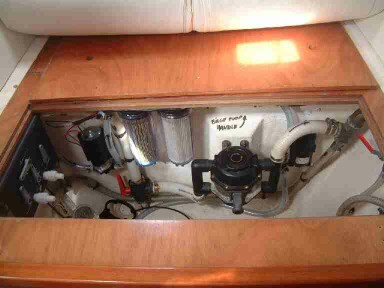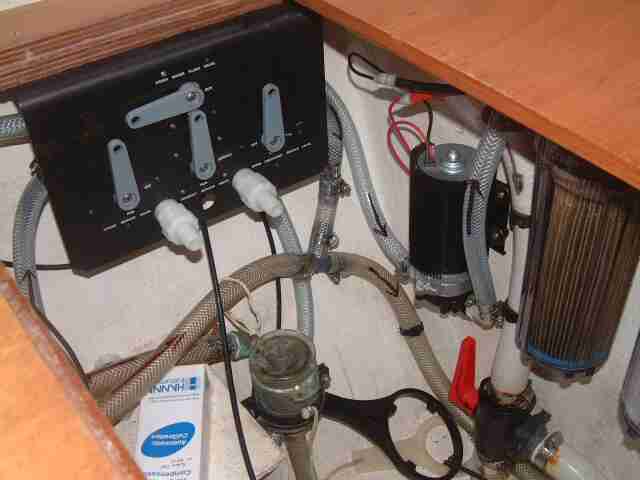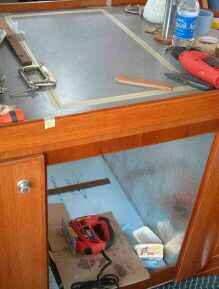

 One of the main things we wanted to add to
Ocelot is a watermaker. Reverse osmosis (RO) watermakers use extremely high
pressure to force some seawater to become even saltier by making some pure water
move through a semi-permeable membrane (exact opposite of normal osmosis, where
pure water moves across a membrane to dilute saltiness.) The
membrane blocks the passage of anything larger than a small portion of a micron.
The resulting water is about as pure as distilled water.
The excess brine, now saltier than normal, is still pressurized. However, most
watermakers just dump it overboard.
One of the main things we wanted to add to
Ocelot is a watermaker. Reverse osmosis (RO) watermakers use extremely high
pressure to force some seawater to become even saltier by making some pure water
move through a semi-permeable membrane (exact opposite of normal osmosis, where
pure water moves across a membrane to dilute saltiness.) The
membrane blocks the passage of anything larger than a small portion of a micron.
The resulting water is about as pure as distilled water.
The excess brine, now saltier than normal, is still pressurized. However, most
watermakers just dump it overboard.
One of my primary jobs when we first got on Ocelot to install a Spectra© watermaker. These RO watermakers use the still pressurized brine to reduce the power required for the next stroke, and can produce several hundred gallons of fresh water per day. Of course, it still requires lots of electricity, so we don't run the watermaker that long. On the other hand, we will probably never have to go and buy water as long as the watermaker is working.
A recent modification we made to the watermaker was the addition of a second electric pressure pump, called a feed pump. The feed pump is the only part of the system which needs electricity, but it takes about eight amps (one hundred watts) DC. How powerful the feed pump(s) are has a direct affect on the production of the watermaker. By adding a second pump in parallel with the first, we can strongly increase our production (not quite double, but a significant amount nonetheless.) The electrical consumption does double (which means our efficiency goes down,) so we only use both pumps when we have lots of excess power (i.e. motoring.) In order to have a better control over these pumps, we installed two circuit breakers on the watermaker's valve panel. Although there is still a master breaker on the main electrical panel, I mainly use the two new ones to turn one pump or the other on or off.
 One of my dad's main jobs, although I
helped, was to install our main
refrigerator. We wanted an air cooled 12V DC
system that does not need us to run the engines and is thermostat controlled. We
also want it to be top opening for maximum efficiency and have a small freezer
section. We acquired a box shaped evaporator plate (the inside is the freezer)
and a lot of polystyrene (Styrofoam) insulation. We then coated the interior of
the fridge, including the doors in the top, in fiberglass, and sanded and painted it
for a smooth finish. After that, we mounted the cooling elements (we are keeping
an old engine-driven holding plate for when we do run the engines.) We also
installed shelves and are considering adding a water tank that lets us get cold water without
opening the fridge. (Click for more about
the fridge.)
One of my dad's main jobs, although I
helped, was to install our main
refrigerator. We wanted an air cooled 12V DC
system that does not need us to run the engines and is thermostat controlled. We
also want it to be top opening for maximum efficiency and have a small freezer
section. We acquired a box shaped evaporator plate (the inside is the freezer)
and a lot of polystyrene (Styrofoam) insulation. We then coated the interior of
the fridge, including the doors in the top, in fiberglass, and sanded and painted it
for a smooth finish. After that, we mounted the cooling elements (we are keeping
an old engine-driven holding plate for when we do run the engines.) We also
installed shelves and are considering adding a water tank that lets us get cold water without
opening the fridge. (Click for more about
the fridge.)
Among the very first things we purchased for Ocelot in St. Martin when we arrived is an inflatable dinghy with a rigid aluminum bottom and a 25 horsepower outboard engine. This dinghy is essentially our car, allowing us to get to shore and to other boats. We have to use other transportation ashore, but any of the four of us can drive the dinghy by ourselves, and with the large engine, we can take many people as well. We also use the dinghy to go snorkeling or diving, since it can quickly take us to a good site where its small folding anchor will hold it for an hour or so while we swim. Each night, and anytime we sail, we hoist the dinghy out of the water on davits at the back of Ocelot. (Click for more about the davits.)
Sailing certainly isn't all play, but it isn't all work either. One fun thing to do in anchorages is go out in a sailing dinghy. These small boats, which have no engines, are good fun for one or two people in light winds. That doesn't mean they require no work, however. First, it takes some work to set them up, and some to store them. More of the work, however, has been to devise a means of storing our sailing dinghy so that it won't come loose or get damaged when we take big waves over the bow. What we decided to do was to store it upside down on our tramps by attached clips. We tied on the clips and prepared the lines for tying the dinghy down. It can now be launched in a matter of minutes, and secured just as quickly. Best of all, it is not going to damage itself or Ocelot.
Top Level: Home | Destinations | Cruising Info | Underwater | Boat Guests | Ocelot | Sue | Jon | Amanda | Chris | Site Map | Make a Comment
![]()
|
If our information is useful, you can help by making a donation |
Copyright © 2000‑ Contact: Jon and Sue Hacking -- HackingFamily.com, svOcelot.com. All rights reserved.